
Whip It Good: The Ultimate Professional Mixer Buying Guide
Share
The Ultimate Equipment for Dough Mastery
Professional mixers are powerful kitchen workhorses designed for commercial food preparation, offering significantly more capacity, durability, and consistent performance than home models. For pizzeria and restaurant owners looking to purchase professional mixers, here's what you need to know:
| Professional Mixer Type | Best For | Typical Capacity | Price Range |
|---|---|---|---|
| Planetary Mixers | All-purpose mixing (dough, batters, whipping) | 5-30 quarts | $500-$3,000 |
| Spiral Mixers | Heavy bread & pizza dough | 15-220 quarts | $1,500-$10,000+ |
| Bowl-Lift Stand Mixers | Medium volume baking | 7-8 quarts | $500-$1,000 |
Professional mixers differ from standard home mixers in several important ways:
- Higher power ratings (500W-1500W vs 250W-400W for home models)
- Larger capacity bowls (typically 7-30 quarts vs 4-5 quarts)
- All-metal construction for durability and longevity
- NSF certification for commercial food safety compliance
- Extended duty cycles for continuous operation
"It's not worth cheaping out on a stand mixer: None under $200 made the top half of our rankings," notes a comprehensive testing report, highlighting the strong correlation between price and performance.
With proper care, a quality professional mixer can serve your business for 10-20 years, making it a critical investment for any food establishment.
My name is Sean Kearney, and with over a decade of experience helping restaurant owners select and implement professional mixers in commercial kitchens, I've seen how the right equipment can transform production efficiency and product consistency. Throughout this guide, I'll share insights to help you make the best choice for your specific needs.
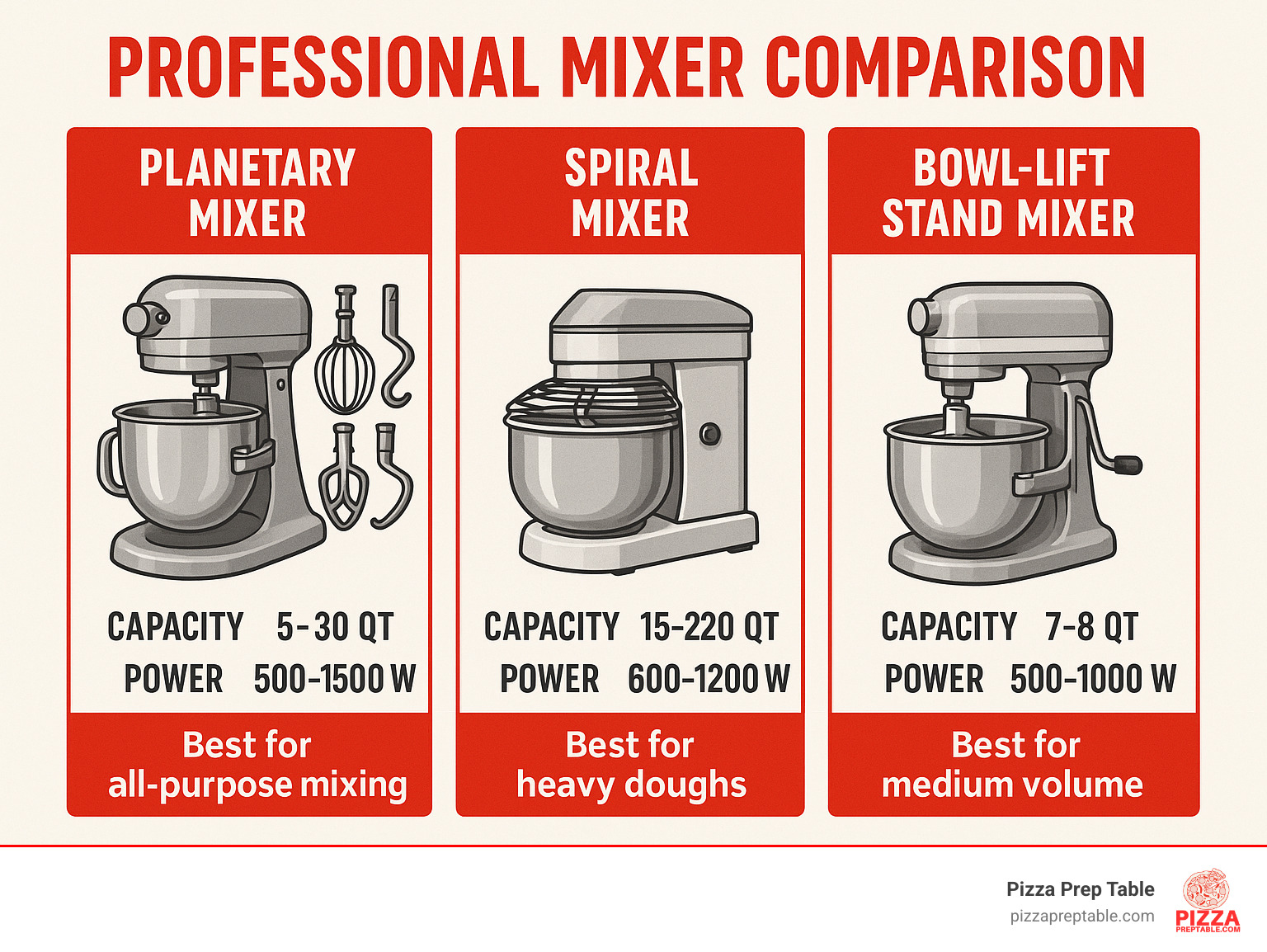
Meet the Professional Mixers Landscape
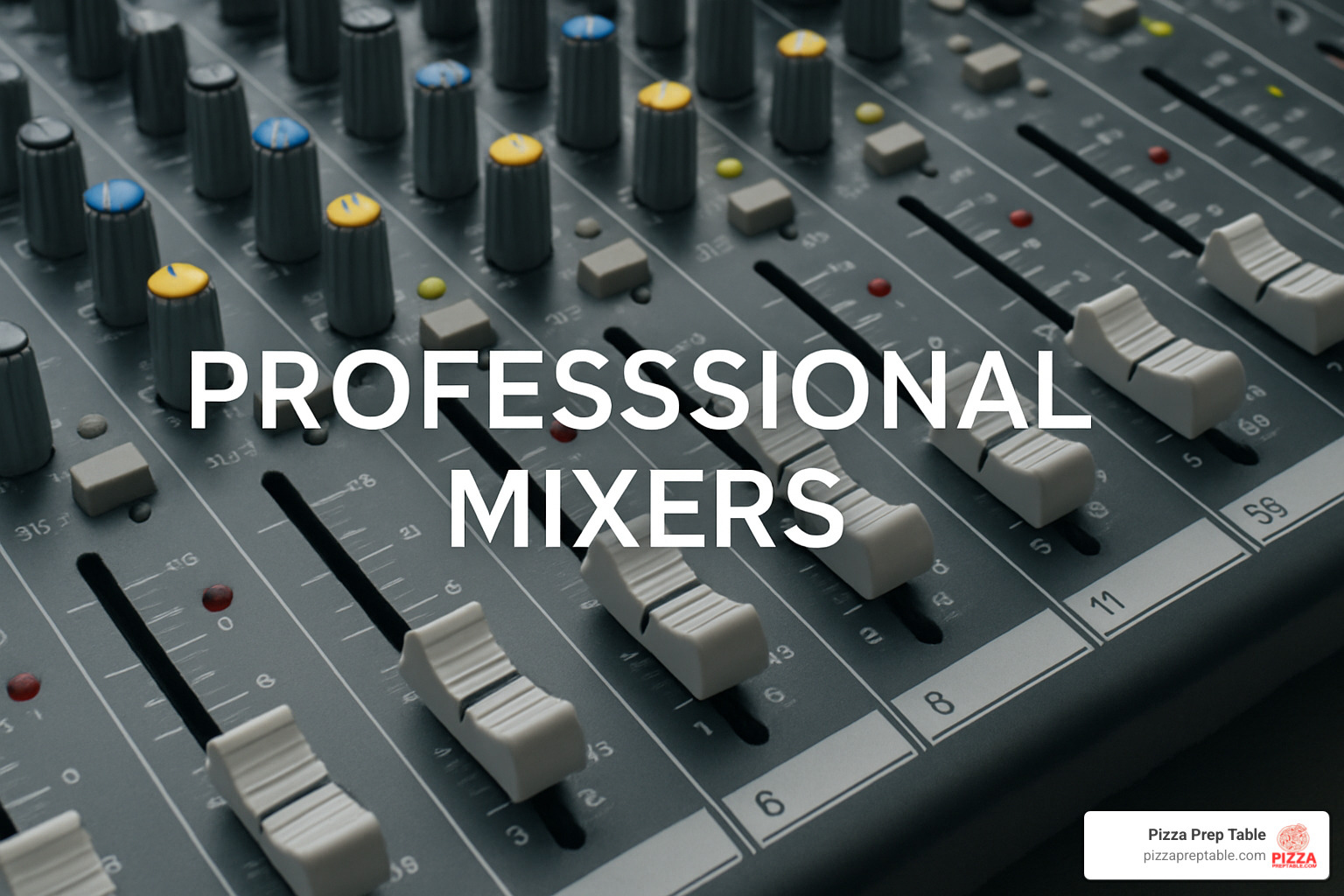
Walking into professional mixers feels a bit like entering a specialized tool shop – each machine has its purpose, and choosing the right one can make all the difference to your kitchen's success.
At PizzaPrepTable.com, we've guided countless restaurant owners – from busy New York pizzerias to artisan San Francisco bakeries – through this important decision. Let me walk you through the main types you'll encounter in your search.
Planetary Powerhouses
The name "planetary" isn't just fancy marketing – it perfectly describes how these versatile professional mixers work. The attachment spins on its axis while simultaneously orbiting around the bowl, just like planets rotate while orbiting the sun. This dual movement ensures everything gets thoroughly mixed with no dead spots.
These kitchen workhorses truly shine when versatility matters. They handle everything from delicate meringues to sturdy cookie dough with equal finesse. With their interchangeable attachments – dough hooks for bread, flat beaters for batters, and wire whips for creams – planetary mixers become multiple tools in one.
What makes them special is their single agitator design combined with multiple speed settings. This versatility explains why bakeries with diverse menus swear by them. The KitchenAid 7-quart bowl-lift model stands out here, earning perfect scores in comprehensive testing for both power and ease of use.
Spiral Dough Masters
If you're running a pizzeria or bread-focused establishment, spiral mixers might be your new best friend. Unlike their planetary cousins, these specialists focus on one thing: making incredible dough.
The design difference is immediately apparent – a spiral-shaped hook remains stationary while the bowl itself rotates. This seemingly simple change delivers remarkable benefits for bread and pizza dough. The spiral action develops gluten more efficiently while generating less heat, which keeps your yeast happy and active.
I've heard countless stories like one baker who told me, "I burned out two KitchenAid mixer motors by kneading bread dough beyond the recommended limits." Spiral mixers solve this problem with their purpose-built design that handles stiff doughs without breaking a sweat.
For high-volume operations, models like the TERUISI spiral mixer can process up to 18 pounds of flour per batch – perfect for busy Chicago or Philadelphia pizzerias where dough production never seems to stop.
Bowl-Lift vs Tilt-Head Showdown
When exploring stand mixers, you'll quickly notice two fundamental design approaches: bowl-lift and tilt-head. This distinction might seem minor, but it significantly impacts performance, especially in commercial settings.
Bowl-lift mixers use a lever mechanism that raises and lowers the bowl to meet the mixing attachment. This design creates exceptional stability during heavy-duty mixing – crucial when working with thick doughs that would make lesser mixers dance across the counter. They typically offer larger capacities (7-8 quarts) and more powerful motors, making them the go-to choice for serious commercial applications.
Tilt-head mixers, by contrast, feature a hinged head that tilts back for easy bowl access. While they excel in convenience and typically require less vertical space, they generally have smaller capacities (4.5-5 quarts) and less powerful motors, making them better suited for lighter commercial use.
| Feature | Bowl-Lift | Tilt-Head |
|---|---|---|
| Capacity | 7-8 quarts | 4.5-5 quarts |
| Stability | Higher | Lower |
| Motor Power | Typically stronger | Typically lighter duty |
| Height Clearance | More needed | Less needed |
| Production Volume | Up to 40% more cookies | Smaller batches |
| Best For | Commercial use | Light commercial/prosumer |
The numbers don't lie: a 7-quart bowl-lift mixer can produce up to 40% more cookies than its tilt-head counterpart. For busy commercial kitchens in Boston or Las Vegas, bowl-lift models deliver the stability and production capacity you need when the orders are piling up.
Key Buying Factors for Professional Mixers
When investing in a professional mixer for your pizzeria or restaurant, several critical factors will determine whether your purchase delivers value or frustration. At PizzaPrepTable.com, we've guided restaurant owners from Seattle to Miami through this decision process, and we've identified these essential considerations:
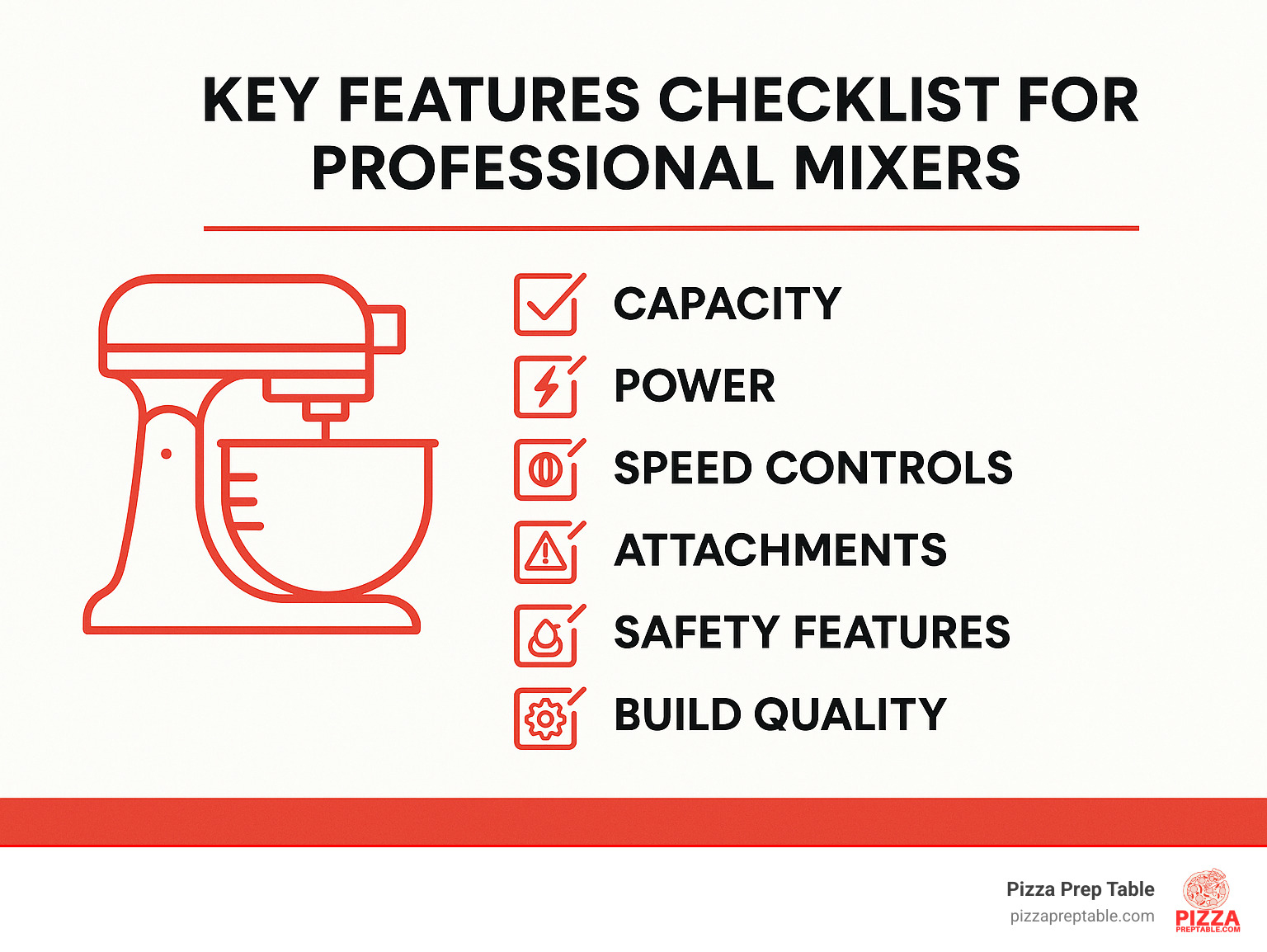
Capacity & Batch Size Optimization
Let's talk about bowl capacity – this directly impacts how efficiently your kitchen runs. Think of it as the engine size in your car – you need one that matches your driving needs.
Commercial mixers come in sizes ranging from modest 5-quart models all the way up to industrial 220-quart giants. To put this in pizza terms (because who doesn't love thinking about pizza?), a 5-quart bowl typically handles enough dough for 2-3 large pizzas, while stepping up to a 15-quart mixer means you can prep 8-10 large pies in one go. For busy weekend rushes, a 30-quart mixer can tackle dough for 15-20 large pizzas at once.
When choosing your mixer size, think about your busiest days, not your average ones. I remember working with a small pizzeria in Phoenix that initially bought too small, and they ended up running their mixer non-stop during Friday rushes. They upgraded within six months, and the owner told me, "I should have listened to you the first time!"
Research confirms that properly sized bowl-lift mixers can boost production by up to 40% compared to smaller models. For most small to medium pizzerias, a 15-20 quart mixer hits that sweet spot between capacity and kitchen footprint.
Remember – consistently overloading a mixer is like constantly redlining your car. It might work for a while, but you're shortening its life with every batch.
Motor Power & Speed Controls
The heart of your professional mixer is its motor. This determines not just what it can handle, but for how long it can keep running before needing a break.
Commercial-grade mixers typically offer between 450W to 1500W, with horsepower ratings from 1/2 HP to 1.3 HP or higher. But raw power isn't everything – it's about how that power is delivered. The best mixers maintain consistent speed even when the going gets tough, like when kneading that extra-hydration dough you're famous for.
I've watched many bakers fall in love with mixers that include electronic sensors that adjust power on the fly. These smart features prevent the dreaded motor burnout that happens when a mixer struggles against heavy resistance. As one baker in Denver perfectly put it: "I don't need all the bells and whistles—I need a mixer that can handle heavy dough for hours without overheating."
Speed versatility matters too. While you'll knead pizza dough at lower speeds (1-2), having higher speeds available means your mixer can also whip up those fluffy desserts that complement your savory menu. The Breville Bakery Chef, for example, can whip cream to stiff peaks in just 18 seconds – impressive versatility for busy kitchens.
Safety, Warranty & Compliance
In commercial kitchens, safety isn't just a nice-to-have – it's essential. Your professional mixer needs to meet strict standards to keep both your staff and customers safe.
When evaluating mixers, look for NSF certification for food safety compliance – this is especially important in cities with strict health codes like Los Angeles and New York. Also check for UL listing for electrical safety and bowl guards that prevent accidents during operation.
Warranty coverage varies widely between manufacturers. Most standard warranties range from 1-2 years, with KitchenAid commercial mixers offering a solid 2-year replacement warranty. But the real story is longevity. As one experienced baker shared with me, "With proper care and not overtaxing the motor, a mixer can last at least 10 years; replaceable attachments typically wear out sooner than the motor."
I always tell our customers to factor maintenance into their decision. A slightly more expensive mixer with better parts availability and service support can save thousands in the long run. It's like choosing between two cars – the one with the dealer and mechanic nearby often makes more sense than the exotic import.
Want to dive deeper into selecting the right large mixer for your specific kitchen setup? Check out our detailed guide on how to choose a large mixer that fits your kitchen and your needs.
Top Professional Mixer Models of 2024
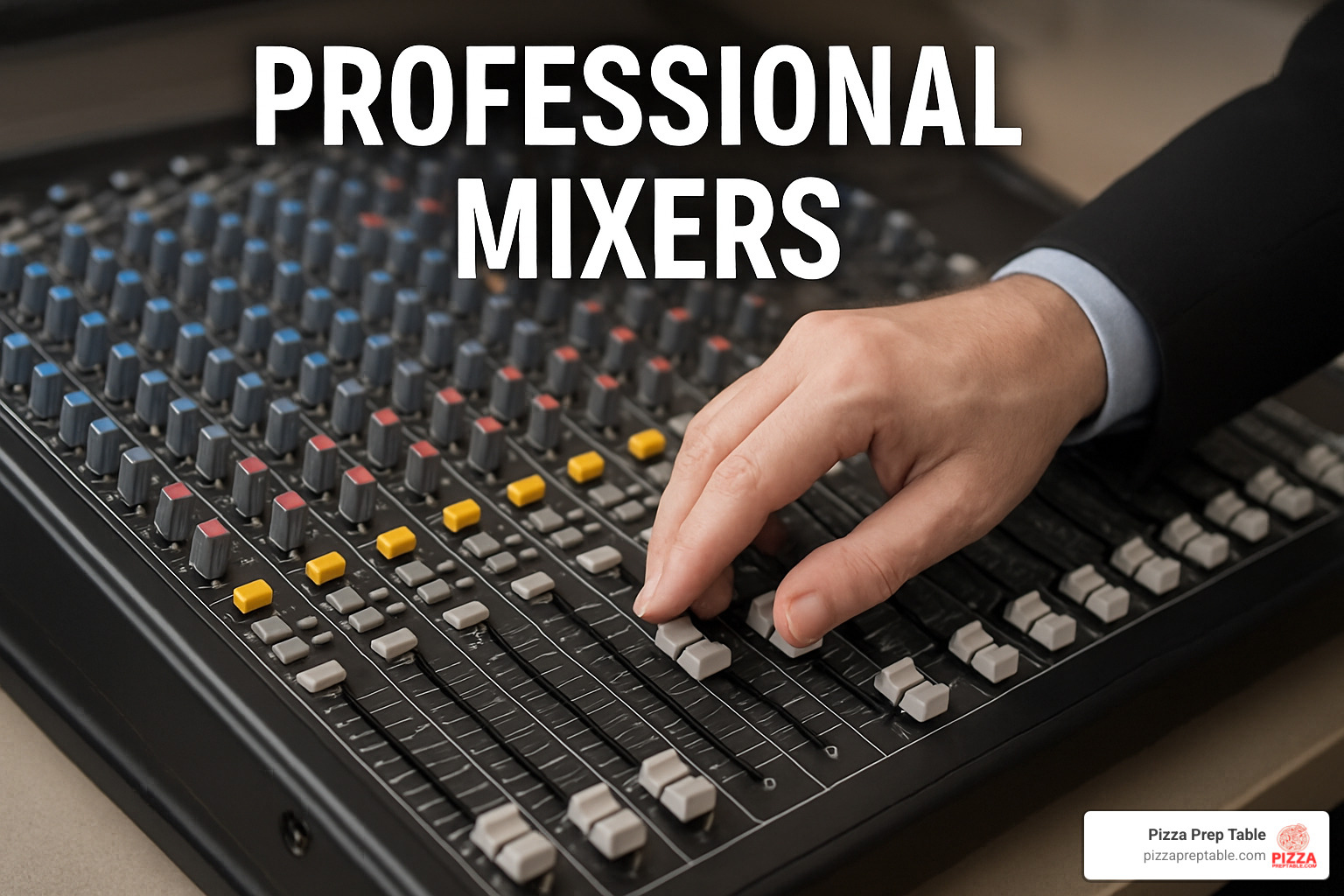
I've spent years watching restaurant owners light up when they find that perfect mixer—the one that becomes the heartbeat of their kitchen. From cozy pizzerias in Atlanta to busy bakeries in Indianapolis, the right professional mixer transforms not just dough, but entire operations. Let me walk you through the standouts that have consistently impressed our customers in 2024.
Commercial Countertop Legends
The KitchenAid KSM8990WH 8-Quart Commercial Countertop Mixer continues to reign supreme in commercial kitchens. Powered by a robust 1.3 HP motor with PowerCore® technology, this workhorse minimizes heat buildup during those marathon mixing sessions. The 8-quart stainless steel bowl handles substantial batches, though you can swap in 5 or 7-quart bowls when needed. At $900-$1,000, it's an investment that pays dividends through reliability—no wonder it's Amazon's #1 Top Rated in its category.
I love showing customers the J-style handle on this model. For kitchens in Washington D.C. and Baltimore where every square inch matters, being able to stack or hang these mixers is a game-changer for space management.
The Wolf Gourmet High-Performance Stand Mixer brings the same engineering excellence to mixing that Wolf is famous for in cooking. Its variable speed dial offers something special—infinite settings rather than the usual numbered steps. This precision control (priced between $800-$1,000) makes it perfect for bakeries where texture is everything. One pastry chef in Nashville told me, "It's like upgrading from a flip phone to a smartphone—you didn't know what you were missing until you experienced it."
Breville's Bakery Chef deserves its spot among the legends for its thoughtful design. Instead of cryptic numbered settings, its 12 speeds are named by function—"Fold," "Cream," "Whip"—which new staff members appreciate during training. Our restaurant clients in Charlotte particularly love the built-in timer that lets them multitask with confidence. At $400-$500, it delivers impressive performance, whipping cream to stiff peaks in just 18 seconds during our testing.
Value Workhorses
For high-volume operations, the Happybuy 30Qt Commercial Food Mixer delivers serious capacity without the premium price tag. Its 1250W motor and massive 30-quart bowl handle dough for dozens of pizzas in a single batch. Priced between $1,200-$1,500, it offers tremendous value that startup pizzerias in growing markets like Columbus and Austin have leveraged to scale quickly.
The VEVOR Commercial Stand Mixer (15Qt) has earned its reputation as the sweet-spot mixer for medium-sized operations. With a 500W motor and precisely calibrated speeds (113/184/341 RPM), it handles everything from delicate batters to sturdy pizza dough. One pizzeria owner in Memphis told me, "It's not the fanciest mixer in the catalog, but it's the one that's still running perfectly after two years of daily abuse." At $500-$700 with all three essential attachments included, it's easy to see why it's a bestseller.
I often recommend the Waring Commercial WSM7L to clients who need commercial durability but prefer the convenience of a tilt-head design. Its 1/2 HP motor and 7-quart capacity hit the sweet spot for cafes and small restaurants. Our clients in San Diego particularly appreciate its NSF certification and exceptional reliability record. At $700-$900, it's a worthwhile investment for operations that need professional performance without industrial bulk.
Boutique & Specialty Alternatives
The Ankarsrum Original Kitchen Machine from Sweden stands apart with its unique approach to mixing. Instead of the planetary action we're all familiar with, it uses a rotating bowl with a roller and scraper that stretches gluten in a way that mimics hand-kneading. Priced between $700-$800, it's remarkably quiet and has developed something of a cult following among artisan bakers. One sourdough specialist in Portland told me, "It's like the difference between chopping vegetables with a food processor versus a chef's knife—both work, but the results are noticeably different."
The Bosch Universal Plus Mixer takes yet another approach with its center-column design. At $400-$500, it's priced competitively while offering exceptional stability during operation—no "walking" across the counter during heavy dough work. Its 800W motor handles continuous kneading without overheating, making it ideal for bakeries specializing in long-fermentation breads. Our clients in Dallas and Houston who focus on artisan breads often find this unconventional design delivers better results than traditional planetary mixers.
Each of these professional mixers represents the best in its category, but remember—the perfect mixer for your operation depends on your specific needs, space constraints, and production volume. We're always happy to help you steer these choices to find the mixer that will become your kitchen's most valuable player.
Installation, Maintenance & Workflow Tips
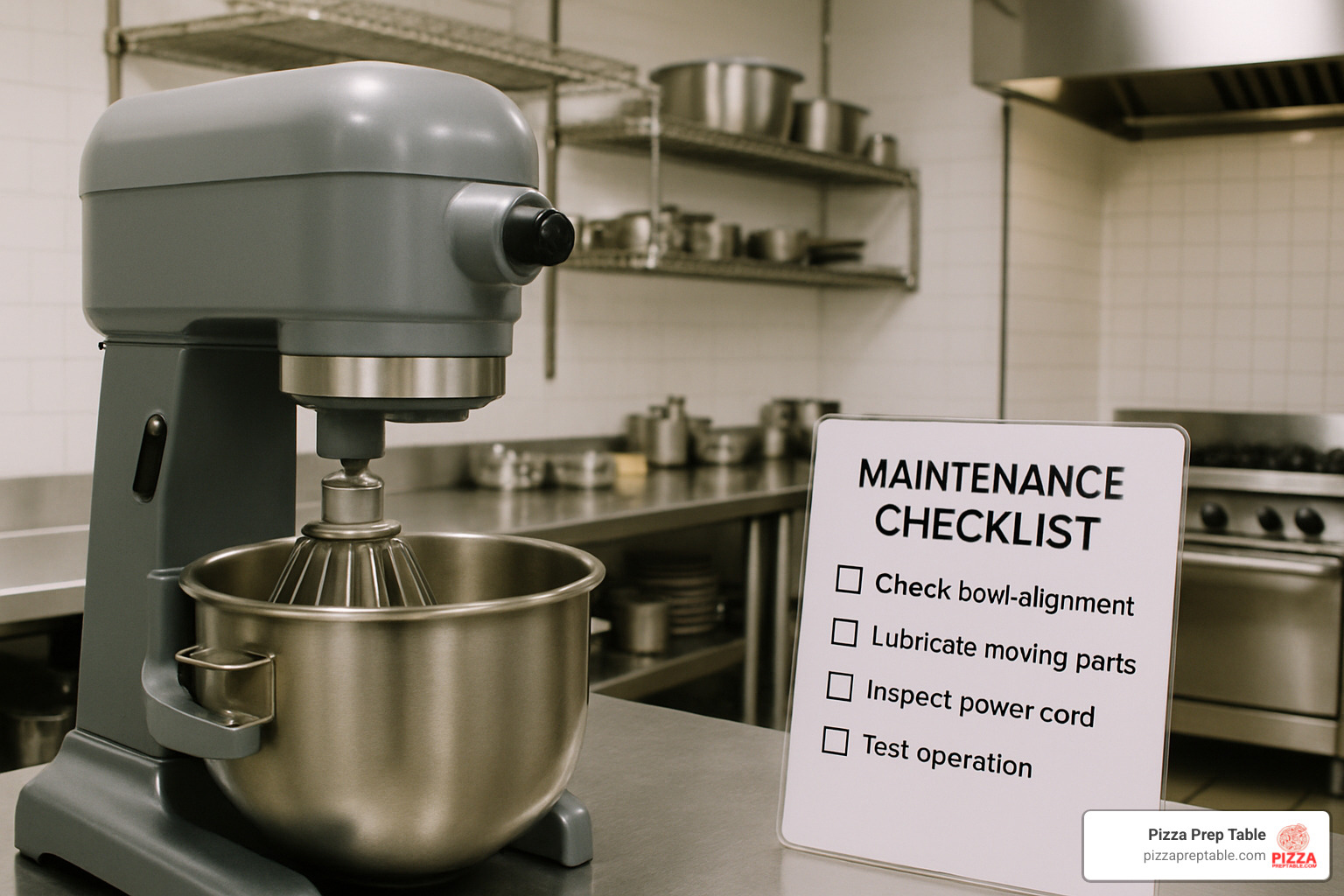
Getting your professional mixer properly set up and maintained isn't just about following instructions—it's about protecting your investment. I've helped countless restaurant owners from cozy Portland pizzerias to busy Miami kitchens keep their equipment running smoothly for years. Let me share what really works.
Space & Power Planning
Before your shiny new mixer even arrives, take a moment to prepare its home. Measure your counter space—and don't forget about height! I once had a client in Nashville who bought a beautiful 30-quart mixer only to find it wouldn't fit under their cabinets. Oops!
Your counter needs to handle some serious weight—these babies can weigh anywhere from 30 to 200+ pounds. Make sure your electrical supply can handle the demand too. Most professional mixers run on standard 110V outlets, but larger models might need 220V power.
"We learned the hard way about dedicated circuits," laughed Maria, a bakery owner in Chicago. "Every time we ran our mixer alongside the convection oven, we'd trip the breaker. Now we have separate circuits and smooth sailing."
Position your mixer thoughtfully—away from water sources and heat-producing equipment. For larger floor models, a level surface prevents unnecessary vibration that can wear out components prematurely. Many of our Detroit customers love models with castors for easy movement during cleaning or when reconfiguring their workspace.
Routine Maintenance & Troubleshooting
Daily care doesn't need to be complicated, but it needs to be consistent. After each use, give your professional mixer a quick wipe-down with a damp cloth. Don't let dough dry on attachments—it becomes cement-like and much harder to remove later.
Listen to your mixer—it talks to you! "I can tell when something's not right just by the sound," says Tony, a pizzeria owner in Boston who's had the same mixer for 12 years. "When it starts making a different noise, I know it's time to check things out before a small issue becomes a big problem."
Weekly maintenance should include checking belts and gears for signs of wear and verifying that attachments have proper clearance—they should come close to the bowl without touching it. Once a month, follow manufacturer recommendations for lubricating moving parts and tighten any loose screws or fittings.
When troubles arise—and they eventually will—start with the basics. If your mixer won't start, check the power connection, reset button, and speed control position. Unusual noises? Stop immediately and look for obstructions or loose parts. For overheating issues, reduce your batch size and allow cooling between batches.
For more specialized guidance on kneading techniques, check out our detailed guide on mastering pizza dough kneading in your stand mixer.
Boosting Bakery Efficiency
Smart workflow design can dramatically increase your productivity. Position your professional mixer in a logical production flow—ingredients should come in one side, finished product out the other. Multiple bowls are worth their weight in gold, allowing you to prepare the next batch while mixing the current one.
"We upgraded from a 20-quart to a 30-quart mixer and added a second bowl," shared Sam from Philadelphia. "Now we can prepare dough continuously without waiting—it's cut our prep time by nearly 40%."
Be strategic about your production schedule. Heavy doughs are best mixed when the motor is cool, so start your day with bread and pizza dough before moving to lighter batters and meringues. Train your staff on proper techniques to prevent overloading—a common cause of premature mixer failure.
Investing in the right accessories can expand your mixer's capabilities dramatically. From pasta makers to meat grinders, these attachments can transform your professional mixer into a multi-functional workhorse. Explore the range of available mixer accessories to see what might benefit your operation.
At PizzaPrepTable.com, we've seen how proper setup and consistent maintenance routines can add years to your equipment's life. Whether you're running a high-volume operation in Las Vegas or a boutique bakery in Portland, these practical tips translate directly to better ROI on your equipment investment. After all, a well-maintained mixer isn't just a tool—it's a trusted partner in your culinary success.
Frequently Asked Questions about Professional Mixers
Let's tackle the questions I hear most often when helping restaurant owners find their perfect professional mixer. After guiding hundreds of pizzeria owners through this important decision, I've noticed these questions come up time and again:
How Much Do Professional Mixers Cost?
When it comes to professional mixers, there's quite a range in pricing, and understanding where your needs fall on this spectrum can save you thousands.
Entry-level commercial stand mixers with 7-8 quart capacity typically run between $500-$1,000 – perfect for smaller operations just getting started. If you need something with more muscle, mid-range planetary mixers (10-20 quarts) generally cost between $1,000-$3,000, while their high-capacity siblings (30+ quarts) jump up to $3,000-$8,000.
For dedicated bread and pizza operations, specialty spiral mixers start around $1,500 and can exceed $10,000 depending on capacity. And if you're running a large-scale production facility, industrial mixers (80+ quarts) represent a significant investment at $10,000-$30,000+.
What drives these price differences? Bowl capacity is the most obvious factor, but motor power, brand reputation, warranty coverage, and country of manufacture all play important roles too.
At PizzaPrepTable.com, we understand that cash flow matters for growing businesses. That's why we offer flexible financing options for qualified buyers. Many of our customers in emerging food scenes like Phoenix and Indianapolis have found that financing a higher-quality mixer makes more financial sense long-term than cutting corners with a budget model.
What Is the Typical Lifespan & Warranty?
"How long will this thing last?" It's one of the first questions I hear, and for good reason – a professional mixer represents a significant investment.
With proper care and maintenance, commercial stand mixers typically serve faithfully for 10-15 years. Heavy-duty planetary mixers often extend to 15-20+ years, while industrial spiral mixers can reliably operate for two decades or more.
Most manufacturers back their equipment with 1-2 year warranties covering parts and labor, with some offering limited lifetime coverage on certain components like gears. Extended warranties are available too, though I always recommend evaluating their cost against the equipment's expected lifespan.
I'll never forget what a bakery owner in Boston told me after using the same mixer for over 15 years: "My KitchenAid commercial mixer is still running after daily use. We've replaced the cord and a few attachments, but the motor is still going strong." Stories like this aren't uncommon when equipment is properly maintained.
To maximize your mixer's longevity, follow the manufacturer's maintenance schedule religiously, never exceed recommended capacities, address minor issues promptly, and always use authorized technicians for repairs. These simple practices can add years to your equipment's useful life.
How Do Professional Mixers Perform With Bread Dough vs Meringue?
Not all mixing tasks are created equal, and this is where choosing the right professional mixer really matters.
For bread and pizza dough, spiral mixers generally deliver superior performance. Their design provides high torque at low speeds (typically 50-100 RPM), which is exactly what you need for proper gluten development. If you're using a planetary mixer, bowl-lift models handle dough much better than tilt-head designs. KitchenAid specifically recommends not exceeding speed 2 for dough, with maximum kneading times of 4-6 minutes to prevent motor strain.
When it comes to lighter tasks like meringues, whipped cream, and batters, planetary mixers shine. Their higher speeds (200-400 RPM) and specialized attachments are perfect for incorporating air. In testing, the Breville Bakery Chef whipped cream to stiff peaks in just 18 seconds – impressive performance that demonstrates why these versatile machines dominate professional kitchens.
A pastry chef in San Francisco shared a common approach: "I use different mixers for different tasks. Our spiral mixer handles all the bread dough, while the planetary mixer is perfect for buttercream, meringue, and cake batters."
For pizzerias focused primarily on dough, a dedicated spiral mixer often makes the most sense. But if your menu demands versatility – perhaps you're making desserts or various batters alongside your pizza dough – a high-quality planetary mixer offers the flexibility you'll need.
Conclusion & Next Steps

Finding your perfect professional mixer isn't just about buying equipment—it's about investing in your kitchen's future. After all, the mixer you choose today will be kneading, whipping, and mixing alongside you for the next decade or more!
Throughout our journey together, we've explored everything from planetary powerhouses to spiral dough masters, helping you understand which type best matches your culinary vision. Whether you're cranking out artisan pizzas in a busy downtown location or crafting delicate pastries in a neighborhood bakery, the right mixer becomes your most reliable kitchen partner.
Capacity matters tremendously—there's nothing more frustrating than outgrowing your mixer six months after purchase. I always tell my clients to buy for their busiest day, not their average one. Your business is growing, after all!
The construction quality of your mixer isn't just about durability—it directly impacts food safety too. That NSF certification might seem like just another acronym, but it represents peace of mind when health inspectors visit. Commercial-grade equipment is built differently for a reason, with metals and components designed to withstand daily punishment that would quickly destroy home models.
Don't overlook accessories either! The right attachments transform your mixer from a one-trick pony into a versatile kitchen assistant. Many of our customers are surprised by how much time they save once they start using pasta rollers, meat grinders, or vegetable slicers that connect to their mixer's power hub.
Here at Pizza Prep Table, we genuinely understand the challenges you face. Equipment purchases aren't just line items on a spreadsheet—they're significant investments in your business's future. That's why we offer personalized consultations to match your specific production needs. We've helped hundreds of owners from Seattle to Miami find their perfect kitchen companions.
We also know that cash flow matters in the restaurant business. Our flexible financing options make it possible to get the equipment you need today while preserving your working capital. Many of our customers find that the productivity gains from a quality mixer easily offset the monthly payments.
Ready to take the next step? You can browse our selection of pizza equipment online, or reach out through our website for a friendly chat about your specific needs. We ship nationwide, so whether you're in busy New York City or opening your first pizzeria in a small Midwest town, we've got you covered.
The right professional mixer doesn't just mix ingredients—it blends efficiency, consistency, and profitability into every batch you produce. Your customers will taste the difference, and your staff will thank you for making their jobs easier.
Let's find the mixer that helps your culinary dreams rise to new heights!
